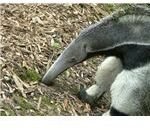 |
| Source: http://tf3dm.com/3d-model/anteater-skeleton-35679.html |
Giant Anteater Facts
Giant Anteaters
 The
giant anteater is an amazing creature that has been around for about 25
million years. Unfortunately, its numbers are decreasing due to habitat
destruction and hunting. It is estimated that 5,000 remain in the wild
and about 90 live in US zoos. Below are many interesting facts about the
giant anteater, which will hopefully be around for many more years.
The
giant anteater is an amazing creature that has been around for about 25
million years. Unfortunately, its numbers are decreasing due to habitat
destruction and hunting. It is estimated that 5,000 remain in the wild
and about 90 live in US zoos. Below are many interesting facts about the
giant anteater, which will hopefully be around for many more years.Description
The giant anteater is the largest species of anteaters. The male's length can reach 7 feet and his weight can exceed 100 pounds. The female is smaller. Giant anteaters have long coarse hair (up to 16 inches on the tail), long front claws (up to 4 inches), and long bushy tails that keep them warm (as a blanket) during the cool weather. They have a long tubular snout. They also have the longest tongue (in relation to body size) of any mammal. It is about 2 feet long and narrow like spaghetti.Habitat
The giant anteater can be found in Central and South America in tropical forests, grasslands, and swampy areas. Unlike the smaller anteater species, it rarely climbs trees. Giant anteaters are terrestrial animals that walk around on their hind feet and front fists (they curl their long claws into their paws making a fist - this helps keep their claws sharp). They are good swimmers and will use their snouts as snorkels.Behavior
Giant anteaters are typically mild-mannered and non-vocal creatures. However, when threatened, they can become quite fierce. They will rear up on their hind legs (using their tail for balance, like a bicycle kickstand), roar, and lash out at their attacker with their strong front legs and sharp claws. They can fight off and even kill their main predators like jaguars.Diet
 As
their name implies, anteaters eat ants. They have no teeth so they lap
up the ants with their long tongues and swallow them whole. They can eat
up to 35,000 ants (and termites) a day. To prevent painful stings,
their tongues dart inside the ant mound about 160 times a minute. They
will spend only a minute at each mound to keep from destroying it. This
way, they can come back and feed from it in the future.
As
their name implies, anteaters eat ants. They have no teeth so they lap
up the ants with their long tongues and swallow them whole. They can eat
up to 35,000 ants (and termites) a day. To prevent painful stings,
their tongues dart inside the ant mound about 160 times a minute. They
will spend only a minute at each mound to keep from destroying it. This
way, they can come back and feed from it in the future.Reproduction
Giant anteaters mate between March and May. Females have one offspring once a year (twins are rare). After a 6 month gestation, they give birth in a standing position, using their strong tails to keep them propped up. The pup (baby) will weigh about 3 pounds at birth, nurse for 6 months, ride on its mother's back for the first year, and leave its mother at 2 years of age.More Information
The following are more interesting giant anteater facts:• Anteaters are active during the day (diurnal) where humans are scarce but adapt to being active during the night (nocturnal) in regions where humans exist.• Their metabolic rates are relatively low because of their diet and lifestyle. They have the lowest recorded body temperature (90.9° F) of any placental mammal.• Giant anteaters have poor vision but excellent hearing and a powerful sense of smell (40 times stronger than man).•Their average lifespan is about 15 years in the wild and about 26 years in captivity.
For more detailed information on this truly amazing animal: http://www.maiaw.com/anteater/
Interesting. Good video too. A face only a mother could love. :-)
ReplyDeleteIt's such an odd creature - one that you don't hear much about!
Delete